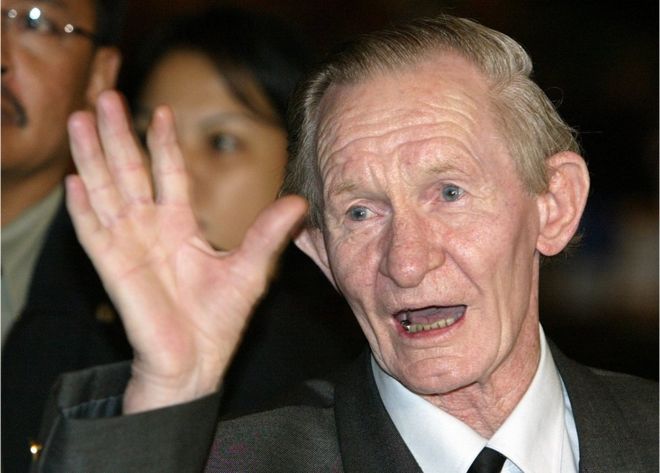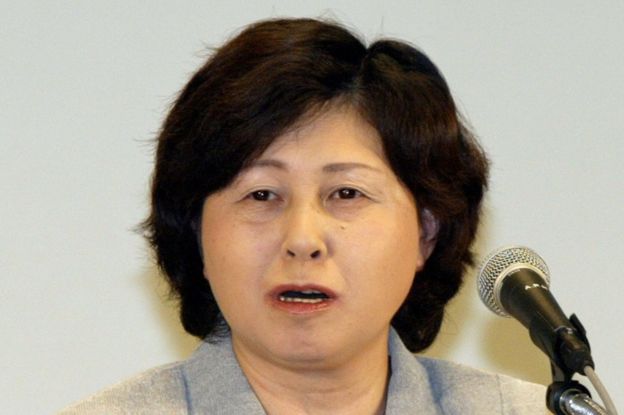 |
| Mr Jenkins walked across the DMZ and surrendered to North Korean soldiers there when he was 24 |
A former US sergeant who defected to North Korea and became Pyongyang's prisoner for nearly 40 years has died.
Charles Jenkins, 77, lived in Japan where he had settled with his family after his 2004 release.
He was among four US soldiers who defected in the 1960s and later became North Korean film stars, but was the only one who was released.
The others reportedly died in North Korea, including James Dresnok who was said to have died of a stroke in 2016.
Charles Jenkins died on Sado island on Monday, where he was living with his wife Hitomi Soga, also a former prisoner of North Korea.
He collapsed outside his home, Japanese media reports said, and later died of heart problems in hospital. His wife said in a statement that she was "very surprised" by his death and "cannot think of anything", according to AFP news agency.
A plan that went wrong
Mr Jenkins had led an extraordinary but also difficult life in North Korea, which he would later chronicle in a memoir and several interviews.
In 1965, while stationed with the US Army in South Korea by the Demilitarised Zone (DMZ), Mr Jenkins decided to abandon his unit and defect to the North, fearing he would be killed in patrols or sent to fight in the Vietnam War.
He said he thought that once in North Korea, he could seek asylum with the Russian embassy, and eventually return to the US in a prisoner swap.
One January night, Mr Jenkins said he downed several beers, walked across the DMZ, and surrendered to North Korean soldiers there. He was only 24 years old.
But Russia did not grant him or the other Americans asylum. Instead, they were held as prisoners by the North Koreans.
"Thinking back now, I was a fool. If there's a God in the heaven, he carried me through it," said Mr Jenkins in a 2005 interview with US broadcaster CBS.
The men were forced to study the teachings of then-leader Kim Il-sung; did translation work; and taught English. But they also became minor celebrities when they acted in North Korean propaganda films, starring as Western villains.
North Korean defectors returned home despite father's plea
North Korea defector wakes after being shot crossing the DMZ
North Korea defector who crossed DMZ 'was shot five times'
Mr Jenkins said his captors often beat him, and conducted medical procedures on him that were sometimes unnecessary or brutal, including cutting off a US Army tattoo without anaesthesia, an experience which Mr Jenkins had described as "hell".
'Oyasumi' and 'Goodnight'
But one bright spot in his life was Ms Soga, who was abducted from Japan to teach North Korean spies her language.
 |
| Ms Soga, seen here in a 2004 file picture, was taken from Sado island |
In 1980, North Korean officials moved her in with Mr Jenkins. Within two weeks they were forced to marry, according to Mr Jenkins, but they eventually fell in love, bonded by their mutual hatred of their captors.
"Well, I'll put it like this. I looked at her one time. I wasn't letting her go," he told CBS.
In his memoir, Mr Jenkins said that every night before they went to bed, he would say "oyasumi" (Japanese for goodnight) to his wife and she would respond in English.
"We did this so we would never forget who we really were and where we came from," he wrote.
The couple had two daughters, Mika and Brinda. Mr Jenkins said that as foreign prisoners, they were treated better than ordinary North Koreans and given rations, even during the famine that swept North Korea in the 1990s.
In 2002, Ms Soga was freed after negotiations by the Japanese government. Pyongyang then allowed Mr Jenkins to leave two years later, along with their daughters.
The family reunited under intense scrutiny from the press in Japan, where there was widespread sympathy.
 |
| Mr Jenkins and his family left North Korea in the early 2000s |
In Japan, he surrendered to the US Army, almost four decades after he had defected, and was court-martialled.
He was eventually given a 30-day prison sentence, and a dishonourable discharge.
'North Korea wants me dead'
The family settled in Sado island, Ms Soga's hometown, and Mr Jenkins eventually found work as a greeter in a tourist park.
But he had to cope with the culture shock of adapting to the modern world, after spending so many years in an isolated country.
He claimed he had never touched a computer, let alone used the internet, and was surprised to see many women serving in the army as well as black people working as policemen, according to CBS.
 |
| Mr Jenkins was given computer training by the US Army while waiting for his court martial in 2004 |
He also suffered from lingering complications from medical procedures he received in North Korea and had to be hospitalised after his release, he told the Los Angeles Times in one of his last media interviews published in August.
Even while living in freedom, Mr Jenkins still remained afraid of his former captors, and was constantly worried that he or his family would eventually be assassinated.
"North Korea wants me dead," he told the paper.
Source: BBCNews

No comments:
Post a Comment
Add a Comment...